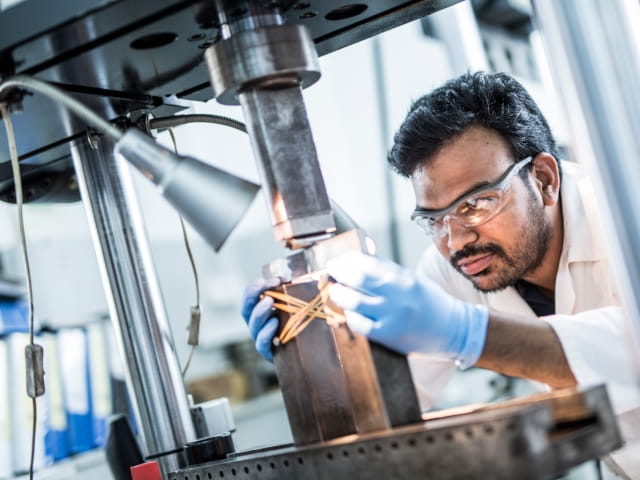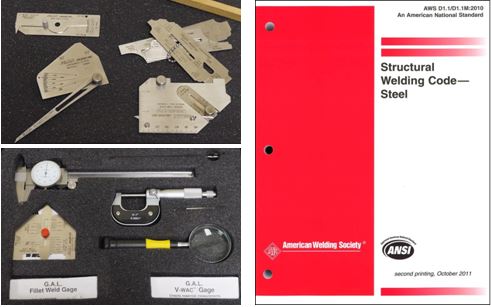Recognizing the Criteria for Welding Inspection Gilbert Arizona: A Total Overview
Recognizing the Criteria for Welding Inspection Gilbert Arizona: A Total Overview
Blog Article
A Comprehensive Overview to Welding Examination: Comprehending Specifications, Techniques, and Best Practices for Quality Control
Welding inspection plays a pivotal function in ensuring the structural stability and security of welded parts, requiring an extensive understanding of market criteria such as those developed by AWS and ASME. As we explore these essential components, it ends up being noticeable that the ramifications of welding assessment prolong much past conformity, inviting a more detailed exam of how these procedures shape industry criteria and methods.
Value of Welding Evaluation
Welding inspection plays a crucial duty in making certain the honesty and safety and security of welded structures. It is an important procedure that validates that welds satisfy predefined specs, which is essential in various sectors, including building and construction, automotive, and aerospace. By carrying out complete assessments, possible flaws such as cracks, insufficient combination, and porosity can be identified early, stopping devastating failings that might result in crashes or pricey repairs.
The significance of welding evaluation prolongs beyond simple compliance with regulations; it additionally promotes trust with stakeholders. Customers and regulatory bodies expect guarantee that the structures they depend on are built to endure operational tensions. Effective welding assessment practices add to long-term sturdiness and efficiency of the frameworks, eventually leading to minimized upkeep prices.
Furthermore, welding assessment promotes a culture of top quality within organizations, encouraging adherence to best methods and continuous enhancement. By incorporating examination procedures into the welding process, firms can improve their reputation and establish themselves as leaders in top quality guarantee. In verdict, the importance of welding examination depends on its capability to guard lives, guarantee structural dependability, and maintain sector requirements, making it a crucial aspect of welding operations.
Key Industry Specifications
Ensuring compliance with essential market criteria is crucial for keeping the quality and safety of bonded structures. Numerous organizations develop these standards to promote finest practices in welding and assessment - Welding Inspection Gilbert Arizona. Among the most identified are the American Welding Society (AWS) and the American Society of Mechanical Designers (ASME), which supply comprehensive guidelines and specifications for welding procedures and evaluation requirements
AWS standards, such as AWS D1.1 for structural welding, overview demands for products, style, and screening to make certain the honesty of welds. Similarly, ASME codes, including ASME Section IX, govern the credentials of welders and welding treatments, ensuring regular top quality in industrial applications. Internationally, the ISO 3834 basic highlights quality needs for combination welding, offering a framework for companies to show compliance with worldwide ideal practices.
Conformity with these criteria not only enhances the dependability of bonded frameworks yet additionally mitigates threats related to structural failings. Adherence to industry criteria is commonly a requirement for governing authorizations and can significantly affect task requirements. Inevitably, understanding and applying these key standards are vital for efficient welding inspection and quality assurance.
Examination Techniques Introduction
Efficient welding inspection depends on a variety of strategies developed to assess the high quality and integrity of welds. These strategies can be extensively classified into destructive and non-destructive screening (NDT) approaches. Non-destructive testing methods, which are widely chosen in the sector, allow for the examination of welds without jeopardizing the stability of the material.

Among the most typically used NDT techniques are aesthetic evaluation, ultrasonic screening, radiographic testing, and magnetic bit testing. Aesthetic assessment is usually the very first step in the analysis procedure, allowing inspectors to recognize surface area flaws and examine weld bead accounts. Ultrasonic screening employs high-frequency sound waves to discover inner imperfections and measure the thickness of welds. Radiographic testing includes the use of X-ray or gamma-ray imaging to reveal inner issues, while magnetic particle screening works for identifying surface area and near-surface gaps in ferromagnetic materials.
Each technique has its own advantages and constraints, making it important for assessors to pick the most suitable method based upon the particular needs of the task, the materials included, and the urgency of the welds being checked. This cautious option supports and makes sure extensive evaluations safety and security look these up and quality requirements in welding operations.
Usual Defects and Their Effects
A comprehensive understanding of common problems in welds is vital for preserving architectural stability and safety and security in bonded buildings. Welding flaws can considerably compromise the mechanical homes of the joint, causing failures that might endanger both employees and tools.
Common issues consist of porosity, which materializes as small gas pockets entraped in the weld metal, compromising the overall framework. Cracking is one more prevalent concern, usually resulting from quick cooling or improper joint design, leading to tension focus that can cause catastrophic failings. Incomplete fusion happens when visit our website the weld metal stops working to properly bond with the base product, developing powerlessness that may cause splitting up under tons.
Other noteworthy problems include damaging, where the weld bead wears down the base metal, and slag incorporations, which can prevent the weld's strength. Each of these flaws has certain effects; for example, porosity can decrease ductility, while cracking directly influences tensile stamina. Identifying and recognizing these issues during examination is crucial for making certain and carrying out restorative procedures conformity with market standards, eventually safeguarding the structural integrity of welded assemblies.
Best Practices for Quality Control
Implementing finest practices for quality control in welding procedures is necessary for attaining optimal results and decreasing issues. One critical practice is the facility of clear welding procedures that comply with market criteria and specifications. These procedures should include detailed instructions regarding material option, joint prep work, and welding methods to make sure uniformity and high quality.
Normal training and qualification of welding workers are additionally essential. Skilled welders who recognize the relevance of quality assurance are more likely to generate audio welds. Furthermore, executing a durable inspection program, consisting of both aesthetic and non-destructive testing (NDT), can assist identify problems early at the same time, allowing for prompt restorative activities.

Lastly, promoting a society of quality within the company Going Here encourages workers to focus on high quality in their job. By sticking to these best techniques, companies can enhance the integrity of their welding processes, eventually resulting in enhanced item high quality and reduced costs connected with rework and repair services.

Verdict
In verdict, welding inspection plays an essential role in ensuring the honesty and security of bonded frameworks. Adherence to key industry standards, such as those established by AWS and ASME, is important for effective quality control. Utilizing various evaluation methods enables the identification of typical issues, therefore minimizing possible risks. By applying ideal methods, organizations can enhance dependability, reduce maintenance expenses, and grow trust among clients, ultimately contributing to effective welding operations - Welding Inspection Gilbert Arizona.
Additionally, welding inspection promotes a society of top quality within companies, urging adherence to ideal practices and continuous improvement. In conclusion, the value of welding inspection lies in its capacity to guard lives, guarantee structural reliability, and copyright market standards, making it an essential facet of welding procedures.
Among the most identified are the American Welding Culture (AWS) and the American Culture of Mechanical Designers (ASME), which give detailed guidelines and requirements for welding processes and evaluation requirements.
Inevitably, understanding and implementing these essential requirements are necessary for efficient welding examination and quality guarantee.
Effective welding examination counts on a selection of methods developed to assess the top quality and integrity of welds.
Report this page